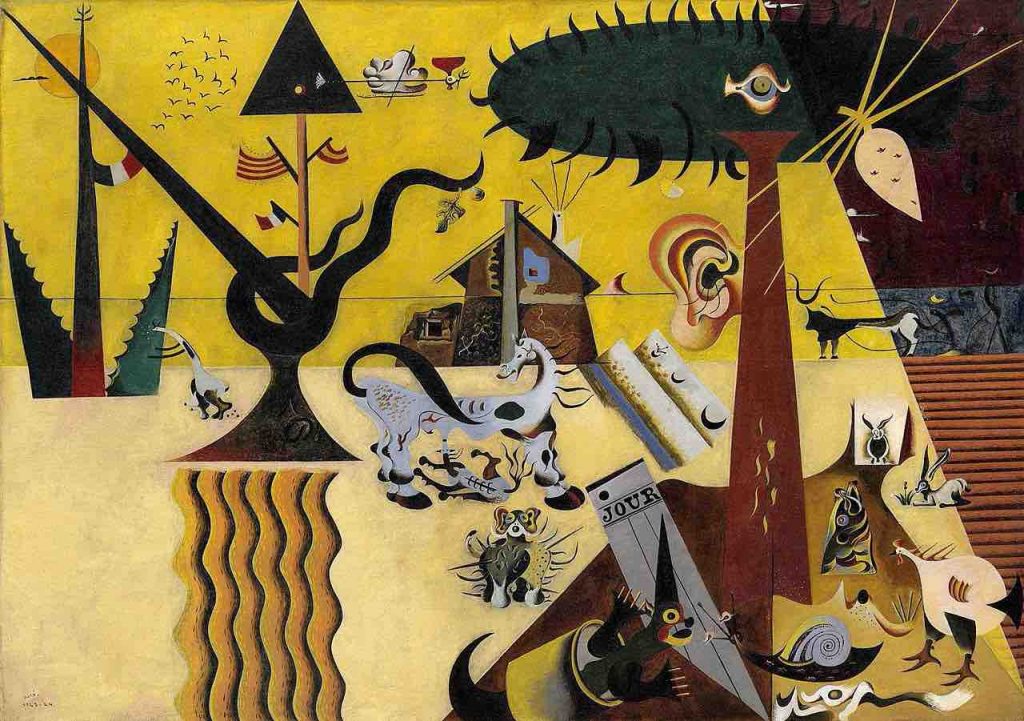This page – dedicated to the Life of Joan Miro – aims to offer a concise biography of the great artist and his works.
In spite of having strong connections with the Surrealistic Group – which he never joined – the painter did not adhere to one particular style but developed his own, employing brilliant colours and simplified forms.
Contrary to many artists of the era, there was nothing Bohemian in his behaviour … in fact, he was hard-working, disciplined, orderly and reliable!
His productive life resulted in at least 2,000 wonderful oil paintings, 500 splendid sculptures, 400 ceramic objects … not to mention some 5,000 drawings and collages!
The fact that he was a prolific print maker – working in etchings and lithographs – also made his work relatively affordable and available.
Joan Miro’s Early Years
- 1893 – Born 20 April – joan miró ferra – in Barcelona, into goldsmith/watchmaker family.
- 1907-1910 – Studies Art at La Escuela de la Lonja, Barcelona.
- 1912-1915 – Studies Art in private Academia Galí. His family wish him to be a businessman/accountant – which he does study for a time, but relinquishes in favour of Art. During this early period, his works are influenced by Cézanne, and he experiments with Cubism and Fauvism.Works include “Still Life with Rose”, “Portrait of E C Ricart”, “Portrait of V Nubiola”, “Prades the Village”, “Cuirana the Path”.
- 1918 – Enters his “Detailistic Phase” or “Poetic Realism Phase”, with methodically-painted works, eg “The Vegetable Garden with Donkey”, “The Wagon Tracks”.
- 1920 – First journey to Paris.
- 1921 – Settles in Paris.
- 1921-1922 – Produces “The Farm” – best of his “Poetic Realism Phase” – bought by Ernest Hemmingway.
- 1924 – Meets several members of Surrealist Group – including Picasso. His real life images are replaced by distorted, abstract shapes and he produces a number of surrealistic paintings, including “Harlequin’s Carnival (1924-25)
- 1926 – Collaborates with Max Ernst on designs for the Russian Sergei Diaghilev.
- 1929 – Marries Pilar Juncosa in Palma de Mallorca.
- 1931 – Daughter – Dolores – is born.
Middle Years
- 1930s – By now, joan miro has developed his own, unique style – not adhering to any one in particular – experimenting with different materials and media.
- 1936-1940 – With the outbreak of Spanish Civil War, returns to Paris. One of his most important paintings of this period is “Still Life With Old Shoe”.
- 1940 – Returns to Spain and starts a series of 23 gouaches Constellations.
- 1947 – Visits United States for the first time. Carries out a number of one-man shows, and realises his dream about monumental art with murals. Has immense influence on post-war art in the States, achieves international recognition, with his works gaining in market value.
- 1956 – Thanks to success in the States, Joan Miró moves into his dream villa/studio in Palma de Mallorca.
Later Years
- 1960-70s – Joan Miró becomes increasingly interested in sculpture.
- 1975 – Fundació Joan Miró opens in Centre d’Estudis d’Art Contemporani, Barcelona.
- 1980 – Receives the Gold Medal of Fine Arts from King Juan Carlos of Spain.
- 1983 – Dies in Palma de Mallorca on 25 December, suffering from heart disease and respiratory problems.
- 1992 – Villa in Palma turned into Miró Museum and opened to the public.
Related pages
- Pablo Piccaso’s Blue Period (What You Need To Know)
- Life of Joan Miro (1893-1983)
- Facts on Salvador Dali (1904-1989)
- Biography of Francisco Goya (1746-1828)
- Biography of El Greco (1541-1614)
- Biography of Diego Velazquez
- Biography For Pablo Picasso

